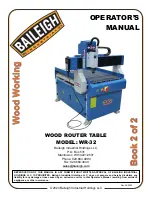
4
Avoid accidental starting. Be sure switch is “OFF” before plugging in.
Carrying tools with
your finger on the switch or plugging in tools that have the switch “ON” invites accidents.
Remove adjusting keys or wrenches before turning the tool “ON.”
A wrench or a key that
is left attached to a rotating part of the tool may result in personal injury.
Do not overreach. Keep proper footing and balance at all times.
Proper footing and
balance enable better control of the tool in unexpected situations.
Use safety goggles (head protection).
Wear safety goggles (must comply with ANSI
Standard Z87.1) at all times. Wear nonslip footwear and a hard hat, if appropriate. Also,
use face or dust mask if cutting operation is dusty and ear protectors (plugs or muffs) during
extended periods of operation.
Tool use and care
Use clamps or other practical way to secure and support the workpiece to a stable
platform.
Holding the work by hand or against your body is unstable and may lead to loss of
control.
Do not force tool. Use the correct tool for your application.
The correct tool will do the job
better and safer at the rate for which it is designed.
Do not use tool if switch does not turn it “ON” or “OFF.”
Any tool that cannot be controlled
with the switch is dangerous and must be repaired.
Disconnect the plug from the power source before making any adjustments, changing
accessories, or storing the tool.
Such preventive safety measures reduce the risk of starting
the tool accidentally.
Keep guards in place.
Maintain the guards in working order and in proper adjustment and
alignment.
Store idle tools out of reach of children and other untrained persons.
Tools are
dangerous in the hands of untrained users.
Never leave tools running unattended. Turn the power “OFF.”
DO NOT leave tool until it
comes to a complete stop.
Maintain tools with care. Keep cutting tools sharp and clean.
Properly maintained tools,
with sharp cutting edges, are less likely to bind and are easier to control. Any alteration or
modification is a misuse and may result in a dangerous condition.
Check for damaged guards or parts, misalignment or binding of moving parts, breakage
of parts, and any other condition that may affect the tool
ʼ
s operation. If damaged, have
the tool properly repaired or replaced before using.
Many accidents are caused by poorly
maintained tools. Develop a periodic maintenance schedule for your tool.
Use only accessories that are recommended by the manufacturer for your model.
Accessories that may be suitable for one tool may become hazardous when used on another
tool.
Service
Tool service must be performed only by qualified repair personnel.
Service or
maintenance performed by unqualified personnel could result in a risk of injury. For example,
internal wires may be misplaced or pinched, or safety guard return springs may be improperly
mounted.
When servicing a tool, use only identical replacement parts.
Use of unauthorized parts or
failure to follow maintenance instructions may create a risk of electric shock or injury. Certain
cleaning agents such as gasoline, carbon tetrachloride, and ammonia may damage plastic
parts.





































